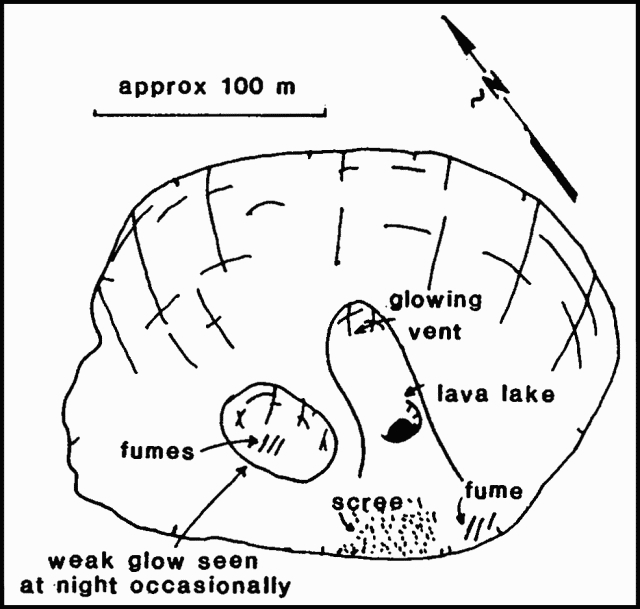Report on Masaya (Nicaragua) — February 1989
Scientific Event Alert Network Bulletin, vol. 14, no. 2 (February 1989)
Managing Editor: Lindsay McClelland.
Masaya (Nicaragua) Lava lake develops in new collapse crater
Please cite this report as:
Global Volcanism Program, 1989. Report on Masaya (Nicaragua) (McClelland, L., ed.). Scientific Event Alert Network Bulletin, 14:2. Smithsonian Institution. https://doi.org/10.5479/si.GVP.SEAN198902-344100
Masaya
Nicaragua
11.9844°N, 86.1688°W; summit elev. 594 m
All times are local (unless otherwise noted)
Geologists observed increased steam emissions within Santiago's inner crater and incandescent fissures on its SE vent walls 12 February. Fracturing progressed gradually until 19 February at 1900, when collapse occurred beneath the SE vent floor. A lava lake, first observed late 20 February inside the SE vent, was about 5 m in diameter at 2200 and had increased to about 30 m by 0600 the next day (figure 6).
 |
Figure 6. Sketch of the inside of Santiago Crater at Masaya based on a photograph taken on the SW crater rim looking NE, February 1989. Courtesy of D.A. Rothery. |
There was some evidence of strong explosive activity, possibly at 2000 on 20 February. Large amounts of Pelé's hair fell on Santiago crater's floor and on the volcano's SW slope. A large hole formed early 21 February in the N wall of the vent. Geologists observed continuous intense lava fountaining (40 m high) in the center of the lava lake that day and the lake level fluctuated by 5-8 m over periods of about 10 minutes. Fluctuations increased to 10-12 m over periods of about 6-8 minutes on 22 February between 2000 and 2400. The lava lake was crescent-shaped and had reached a maximum size of about 40 x 18 m on 22 February. Measurements on 26 February showed the new lava lake to be 175 m below Santiago's crater floor. The lake area varied from hour to hour because of crusting, remelting, and collapse, averaging about 40 m2 28 February-7 March and never exceeding about 100 m2 during that period. Small Strombolian eruptions from the lake surface were frequent. The maximum recorded brightness temperature of the lake was 1,148°C (measured with a Minolta Cyclops 52 infrared thermometer, bandpass 0.8-1.1 µm, 0.33° field of view) during a sustained fountaining event that ejected spatter to ~20 m height. Maximum brightness temperatures for other fountains generally ranged from 1,048° to 1,094°C.
A new vent appeared 23 February in the N corner of the lava lake and exhibited intermittent Strombolian activity. A vent in that vicinity ("glowing vent" in figure 6) had a brightness temperature of 940°C on 28 February, although lava was not visible within it. On 25 and 26 February, small lava flows were slowly extruded from the area between the new vent and the lava lake. Minor amounts of tephra were discharged from the same area on 28 February. Above and west of the lava lake, a third vent that widened by collapse and glowed weakly was the site of considerable degassing but ejected no tephra. Since 20 February, continuous glow and intermittent Strombolian activity inside the 30-m-wide SW vent have suggested the presence of another small lava lake.
Pelé's hair found near the S and SW rims on 1 and 4 March was probably erupted the previous week. Sounds similar to pistol shots were frequently heard from the direction of the active region. A continuously recording seismic station near the summit had registered normal levels of volcanic tremor before the eruptive episodes 19 and 20 February. Beginning 21 February, continuous, high-amplitude, low-frequency tremor was detected.
The last surface lava lake at Masaya was reported in June 1974 and remained continuously visible until January 1978 (3:04). Intermittent glow and deep roaring sounds have been noted since November 1986, when collapse enlarged the crater to 150 m in diameter and 85 m depth (11:11). A small eruption occurred from the inner crater in February 1987 (12:05) and collapse formed 3 small vents in March, June, and December 1987. By January 1988, the inner crater occupied half of Santiago's crater floor (13:01).
Geological Summary. Masaya volcano in Nicaragua has erupted frequently since the time of the Spanish Conquistadors, when an active lava lake prompted attempts to extract the volcano's molten "gold" until it was found to be basalt rock upon cooling. It lies within the massive Pleistocene Las Sierras caldera and is itself a broad, 6 x 11 km basaltic caldera with steep-sided walls up to 300 m high. The caldera is filled on its NW end by more than a dozen vents that erupted along a circular, 4-km-diameter fracture system. The Nindirí and Masaya cones, the source of observed eruptions, were constructed at the southern end of the fracture system and contain multiple summit craters, including the currently active Santiago crater. A major basaltic Plinian tephra erupted from Masaya about 6,500 years ago. Recent lava flows cover much of the caldera floor and there is a lake at the far eastern end. A lava flow from the 1670 eruption overtopped the north caldera rim. Periods of long-term vigorous gas emission at roughly quarter-century intervals have caused health hazards and crop damage.
Information Contacts: Alain Creusot, Dept of Volcanology, Instituto Nicaraguense de Energía, Managua, Nicaragua; C. Oppenheimer and D. Rothery, Open Univ; B. van Vyk de Vries, O. Castellon, and L. Urbina, INETER.

